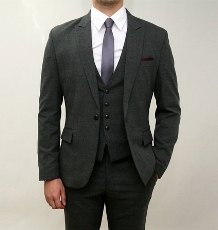
Choosing the right clothing for any job interview requires some thought, but the stakes are especially high if you are applying for a job as a designer. The first impression potential employers have of your design sense is how what kind of outfit you wear. It takes less than a minute for interviewers to form basic impressions of your character and style sense. So how do you ensure that you present the best yourself to the interviewers and make the right first impression?
Know Your Audience
Research the company to which you are applying and the nature of the position. For a large corporation or a position involving supervisory responsibilities, dress conservatively to project an image of trustworthiness and maturity. Agencies may prefer a slightly edgier, more creative, image. Observe what people are wearing in photos on the company’s website or lurk just outside the lobby as people arrive or depart from work to observe the company’s clothing culture.
Interview Clothing Basics
No matter how creative, no one wants staff with questionable personal hygiene. Your outfit should be immaculately clean, pressed, and fit perfectly. Avoid visible piercings and body art. Trim and clean your fingernails and limit jewellery to a watch, an accessory implying punctuality.
Suits
Leave the classic conservative suit to accountants. Instead, try fashion-forward suiting with a touch of colour or texture or a less structured cut or dress down a classic suit by pairing it with a collarless or knit shirt.
Jacket
A stylish dark blazer is a suit alternative. To maintain a sleek silhouette, empty your jacket pockets. Choose a classic cut in a wrinkle-resistant gabardine.
Trousers
Avoid blue jeans. Choose twill or light wool trousers in a dark or neutral shade. Avoid linens, which wrinkle, and pleats, which make you look fat. Save very tight-fitting or stretchy trousers for the gym or bar. Trouser legs should brush the tops of your shoes for either a short or medium break. Wear a belt if trousers have belt loops.
Shirt
Your shirt shows your design sense. Choose a traditional button-down or spread-collar shirt in an interesting colour or fabric or an untraditional design in a neutral colour. For example, pair a navy blazer with a deep cobalt silk shirt or a black suit with a charcoal t-shirt.
Shoes and Socks
Avoid sandals or trainers and polish leather shoes to remove scuffs. Traditional oxfords or loafers and dark socks are safe, but a more colourful shoe can add a splash of style.
Tie
Ties are optional, but can add a splash of colour to an outfit. Consider a hand-painted, vintage, or other creative option.
A marketing director and contributing writer to The Idle Man, Alex Outlaw always has one foot in men’s music, fashion and contemporary culture. He likes to share his advice by blogging and posting on social media. Keep on top of the latest on Twitter here.
Related posts:






